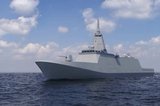DCNS’s F21 torpedo enters final development phase
DCNS’s F21 torpedo has entered into its final development phase following the completion of a qualification round of firing off the Var coast in France, the company announced on 22 June.
The qualification firing was performed in a secured maritime area as part of the Artémis programme led by the French arms procurement agency, the Direction Générale de l’Armement (DGA). The DGA aims to equip all French Navy nuclear submarines with the new F21 heavyweight torpedoes.
The latest test firing was preceded by about 20 industrial sea trials on prototypes from DCNS’s test vessel Pégase and COMEX’s vessel JANUS, as well as from submarines.
The F21 heavy torpedo has been designed to neutralise enemy vessels and submarines. With a range of more than 50km and a speed greater than 50 knots, the F21 is foreseen for operation not only in deep waters but also above all in coastal areas with high levels of noise and dense shipping. Its significant computing power allows for exceptional real-time processing capacities.
The torpedo benefits from an advanced mission system and extended autonomy. These technical characteristics widen its possibilities for tactical use with an unequalled target discrimination capacity, including in very challenging environments.
Franck Dostal, Artémis programme director for DCNS, said: ‘The firing was performed in accordance with the test procedure and communications with the torpedo were operational throughout the exercise. The data recorded in real time could retrace the entire mission, thus validating the achievement of all the goals.’
DCNS’ contract includes the development and delivery of about 100 F21 torpedoes and their integration into all French submarines, which will begin gradually starting in 2018.
More from Naval Warfare
-
![Mitsubishi eyes future with Australia’s Mogami selection]()
Mitsubishi eyes future with Australia’s Mogami selection
With Australia’s selection of the Mogami-class for Project Sea 3000, Mitsubishi is investigating local production in the next decade as potential export opportunities emerge.
-
![Hanwha wins Australian government approval to increase its stake in Austal]()
Hanwha wins Australian government approval to increase its stake in Austal
The contract would mean the two shipbuilders can collaborate strategically and enhance shipbuilding capabilities in Western Australia.
-
![Royal Australian Navy sizes up modernisation plans for new and existing capabilities]()
Royal Australian Navy sizes up modernisation plans for new and existing capabilities
The Australian navy is pushing ahead with its efforts to modernise its workforce and capabilities while balancing risky submarine upgrades, ageing Collins-class boats and a shrinking minehunter fleet. Head of navy capability RAdm Stephen Hughes updated Shephard on the force’s progress.






















